Anyone for Coffee?
Anyone for Coffee?
It is inevitable that the aged care industry has to grow and change, to meet the needs of people coming from the baby boomer generation. A great deal of discussion in aged care revolves around the problems of meeting the increasing number of aged people who were born in the rapid increasing population days of the post World War II era. Whilst meeting the increasing number of people needing aged care services is of paramount concern, aged care managers and staff are also faced with a changing cultural environment and the changing expectations of their clients.
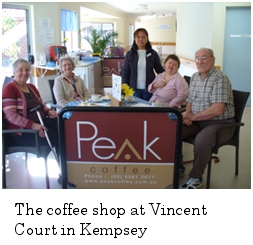
In the report A Generational Shift: The Next Wave of Aged Care (2007) it is suggested that aged care facilities need to strategically plan for the next generation of aged care consumers. The report was based on an interview of 1,291 baby boomers aged between 58 and 61. It highlighted the fact that an overwhelming 92% of respondents gave a high or very high priority to the need for privacy and 84% of respondents gave a high or very high priority to the need to maintain a sense of community.
We are seeing the issue of privacy being addressed in modern aged care building design. The days of the multi-bed sleeping room and a bathroom shared by more than two residents are rapidly disappearing. It is also evident that facilities are placing more emphasis on the development of communal areas.
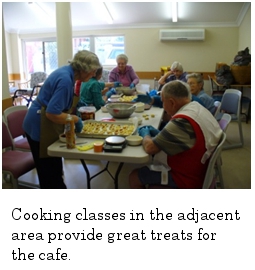
One way in which this is being done is the development of the coffee shop within the aged care facility. From the 1990's on, the coffee shop in the street or shopping centre has taken on increased popularity as a place for people of all walks of life to relax individually or meet with friends and work colleagues. One aged care facility that has taken big strides towards the development of a community coffee shop is Vincent Court in Kempsey. Situated just off the main entrance foyer, the coffee shop features a commercial coffee machine and is adorned with the signage of the locally made PEAK coffee company that supplies the coffee beans to the facility. As facility manager Janet Reay points out "we maintain the more traditional tea and coffee rounds in the room areas but when people come to the coffee shop they want the same experience that they had in the community - real coffee." Cooking classes are also a regular feature of our activities program and the cooking is done in an area adjacent to the coffee shop and so the ambiance of the area is enhanced with the wafts of fresh baking, and the products of this cooking are often consumed in the coffee shop. The other major benefit of this style of coffee shop is that it provides a wonderful venue for the families and friends of the residents to visit and socialise in a setting that they feel very comfortable in.
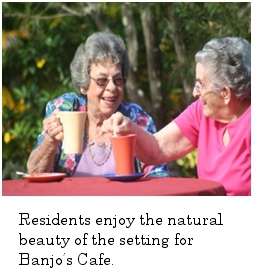
Crowley Aged Care in Ballina, NSW is another facility to embrace the benefits of the coffee shop atmosphere. Named by the residents, Banjo's Coffee Shop not only does ground coffee cappuccinos or whatever coffee or tea drink you would like, but it is open every day and provides a range of food for morning and afternoon teas, and lunch. CEO, Michael Penhey explains that Banjo's was designed to provide both residents and the families with the experience of "going out to lunch". Banjo's Coffee Shop sells a wide range of freshly baked scones and slices for morning or afternoon tea. The lunch menu offers homemade pizzas, sandwiches and a variety of fillings with Turkish bread. Like any other cafe, there a constantly changing daily specials.
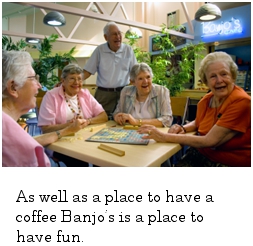
Michael also notes that Crowley is fortunate to be located on the banks of a beautiful river and the facility was keen to take advantage by giving the coffee shop a great view. "Local coffee shops in the town fight to provide their customers with a relaxing view of the river and we are indeed fortunate to be able to achieve this at Crowley".
St Andrew's Aged Care facility in Ballina takes a slightly different approach in that its Copacabana Coffee shop is staffed by auxiliary volunteers and it blends the attributes of real coffee in a kiosk type atmosphere with a profit objective that ploughs the funds back into services for the residents such as the new bus, new chair scales and air-wave mattresses.
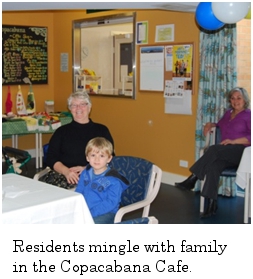
St Andrews adds questions to the annual QPS satisfaction surveys to test satisfaction with the Copacabana Coffee Shop. It generally scores 90% or higher and generates comments such as "great job - the best burgers in town" and "such a fantastic service".
CEO Pip Carter says "the only criticism is that the shop is dependent on volunteers and is not open more often - an issue we are working on."
St Andrews like Vincent Court in Kempsey knows the importance of supporting local business and sourcing local product. In a region that has several coffee producers St Andrews feels the need to explore the options of taking on and promoting a local coffee supplier.
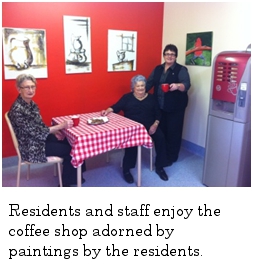
The cafes described thus far are in facilities between 70 and 120 beds and in medium to large regional centres. The development of the coffee shop is not just the domain of the larger facilities and urban areas. The TWG Narrabri facility is just 53 beds and located in central northern NSW. It has established the Sunshine Cafe. Part of the motive for this cafe was to encourage the residents to "sit in the sunshine" and so it is part indoors and part alfresco. As mentioned in a previous article TWG Narrabri has a very active resident art program support by local volunteer artists. The Sunshine Coffee shop is a great place to showcase the wonderful artwork completed by the residents. The Sunshine Cafe is also "internet connected" as it is being found that more and more new residents have either been using or are showing interest in using the internet to stay connected with families and friends.
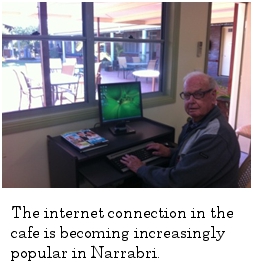
Does the increased effort pay off?
It is noted from the following graph that both the resident and relative satisfaction results from the coffee shop group in this article are significantly higher that the QPS industry wide average. Whilst it should be noted that having a very good coffee shop is just one contributing factor to resident and relative satisfaction, it may indicate that these facilities are tapping into the needs and aspirations of the baby boomer generation.
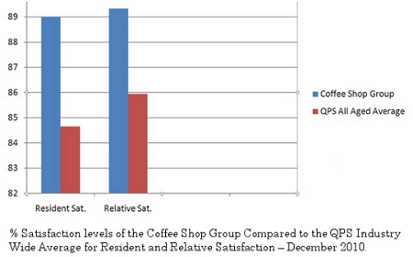
0 comments